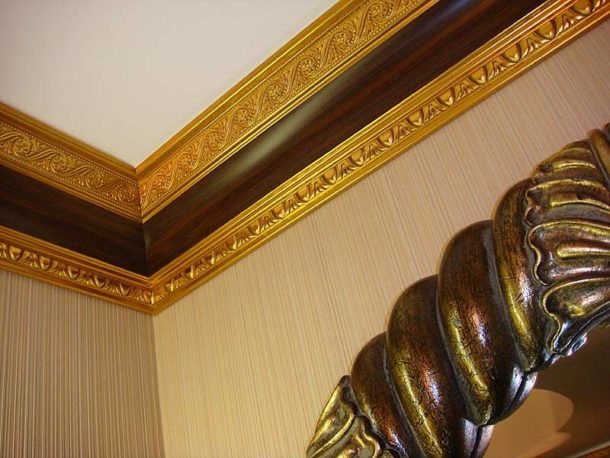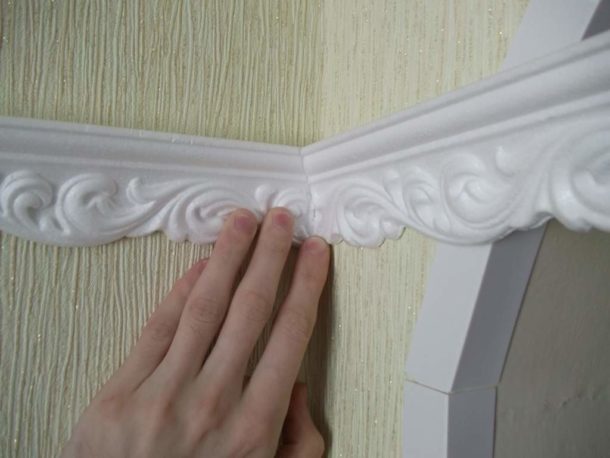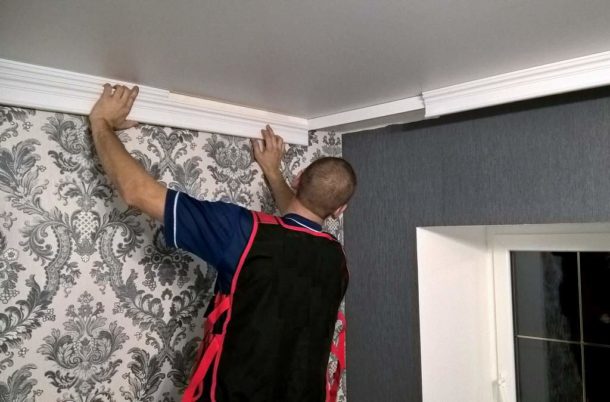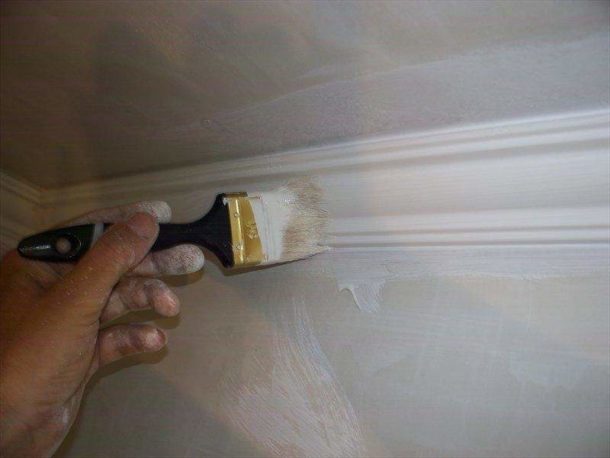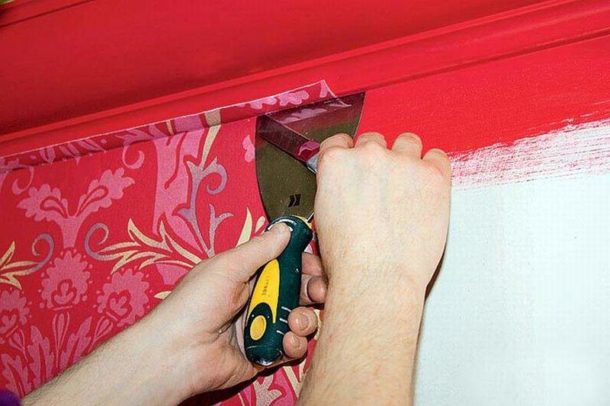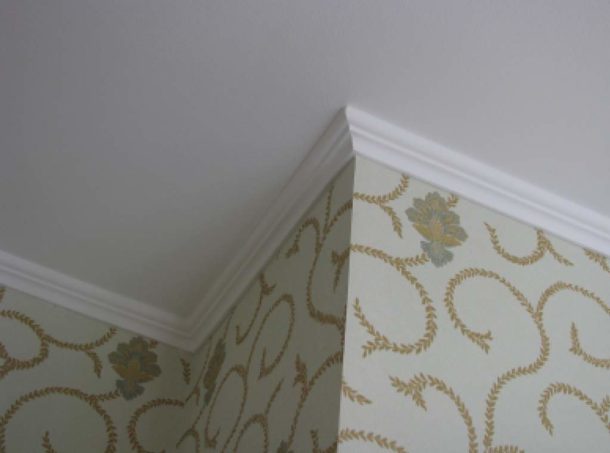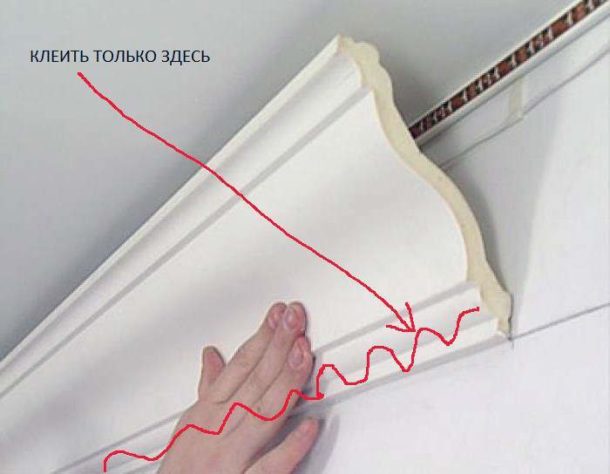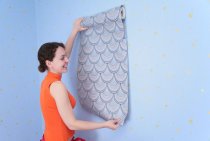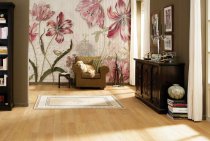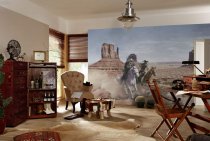The final stage of finishing the room requires special care and accuracy from the master, since any error will be clearly visible. The junction of the wall and ceiling is a difficult area to work with, especially if there are irregularities. The use of fillets facilitates the task and makes the transition from plane to plane more aesthetic. Also, they are perfectly combined with wallpaper, complementing each other favorably. But what needs to be glued first: wallpaper or ceiling plinth?
When can a fillet be mounted on wallpaper?
The ceiling plinth performs decorative and masking functions: with its help, some irregularities of the ceiling are hidden. This opportunity is of high value for the home master, because it is far from always possible to create a perfectly flat surface. A crooked ceiling can ruin the overall look of a room, even with perfectly aligned walls.
To understand whether it is possible to glue fillets on wallpaper, you need to study the varieties of manufactured products and some physical characteristics - weight, material of manufacture, width. To create such decorative elements are used:
- expanded polystyrene;
- Styrofoam;
- polyurethane;
- plastic;
- natural and artificial stone;
- tree;
- ceramics;
- gypsum.
You can glue skirting boards on wallpaper when the canvas is able to withstand their weight for a long time. Therefore, it is better to immediately exclude massive products and consider only light options from all varieties. The easiest way to use baguettes made of expanded polystyrene and polyurethane.
Important! Most often, putty is used to install skirting boards on the ceiling, but they need to be fixed to the wallpaper with a universal transparent glue that quickly sets and does not soak the canvas. Suitable "Liquid nails", "Dragon", "Moment".
The advantage of installing a fillet over the wallpaper is the additional fastening of the joints of the strips where they are most often peeled off - under the ceiling.
Of the minuses, a technical point can be distinguished: if decorative elements require painting, puttying or varnishing, then you need to consider protecting the pasted wallpaper from dirt.
Important! If you decide to use large-relief wallpaper, then you should immediately refuse to stick a frieze on top of them: the fastening will turn out to be unreliable, the plinth can go in waves, and gaps will be visible in the place of contact.
When is the frieze glued first?
Fastening heavy types of baguette requires high bearing qualities from the surface. Therefore, they must be glued directly to the wall and ceiling. For massive varieties (stone, ceramics, wood, gypsum), special metal fasteners are used, mechanically installed in the ceiling.
It should also be understood that heavy products are not able to bend under surface differences. To compensate for gaps and eliminate cracks, acrylic putty is used. Working with this material is a rather messy process, and if by this time wallpaper has already been pasted over on the wall, it is quite difficult to save them from stains and scuffs. In addition, very often paint is applied to the frieze after installation, which is also fraught with damage to the coating.
Conclusion: if the choice fell on a massive ceiling plinth, then wallpapering should be done after its installation and finishing.
However, you need to be prepared for the fact that making a smooth wallpaper edge without noticeable gaps will be much more difficult than using a light frieze that masks errors. Therefore, you should first glue a couple of training cuts in an inconspicuous area.
How to evenly paste wallpaper under the ceiling molding?
To neatly and beautifully trim the wallpaper under the baguette, you need to do the following:
- Glue strips with a slight overlap on the frieze.
- Until the glue dries, take a wide spatula (30 cm) and gently press the canvas to the place of joining with the wall. You can also use an iron ruler for this purpose.
- Then with a knife, without loosening the clamp of the tool, carefully remove the excess. The incision site should run exactly along the edge of the spatula blade.
Important! Only a very sharp knife is used for work, which will not tear the material. When using painting tools with breakable blades, it is recommended to use one section per cut.
- Glue stains that have fallen on the baseboard are removed with a dry, clean rag.
Advice! To feel more confident, it is worth practicing to cut the wallpaper in an inconspicuous area. You can also glue a couple of unnecessary pieces from the roll, and having stuffed your hand on them, just remove them.
Baguette and stretch ceiling
At tension cover installation the question of what is glued in the first place - frieze or wallpaper - appears in a new perspective. The plinth fixing technology is also changing.
The most logical option seems to be in which a stretch ceiling is first mounted, and then a baguette and wallpaper. At the same time, there is no risk that the material on the walls will peel off or be soiled or damaged during the installation of the ceiling structure and skirting boards. The same procedure is followed for all types of suspended ceilings: plasterboard, slatted, Armstrong, PVC panels.
However, in this case, there are risks for the already stretched web, so care should be taken:
- The material may be stained with glue spots during the wallpapering process.
- The adhesive for a plastic baguette can corrode the film, and it will have to be changed.
- Mechanical damage to the ceiling during the installation of heavy baguette fasteners is not ruled out.
If the wallpaper is often re-glued in the room, then it is most advantageous to install a wide molding: the finish will be carried out at a considerable distance from the ceiling, which will prevent its accidental damage.
Installation of a ceiling plinth under a stretch fabric
When installing a frieze under an already stretched ceiling, it is recommended to refuse to stick it on the wallpaper. This will reduce the risk of damage to the film or canvas and greatly simplify the process when changing the wallpaper.
Skirting board installation rules:
- Installation starts from the corner. The baguette is located as close as possible to the stretch ceiling, but should not touch it.
- Fastening of decorative elements is carried out only to the wall and to each other. Care must be taken to ensure that the adhesive composition protruding along the edges does not touch the top coating.
- If putty is used for installation, then the gaps formed at the joints of fragments of the ceiling plinth are also rubbed with it. In the case of using glue for these purposes, a sealant can be used.
Advice! For additional protection of the ceiling during work, a special film is stretched over it, the edges can be pasted over with masking tape.
The rest of the installation steps are general rules for installing ceiling friezes.
Professional opinion
Most experienced finishers believe that it is not worth fixing a baguette on wallpaper, regardless of the material of manufacture and weight. The plinth must be installed on the ceiling before finishing the walls. This approach facilitates all work on the installation, puttying and painting of decorative elements, and also eliminates the need to take protective measures so as not to spoil the wall covering.
Inexperienced home craftsmen in this way are most often scared off by difficulties with high-quality fitting of wallpaper under the baseboard. However, experience is a gain.
